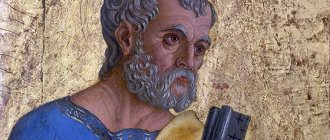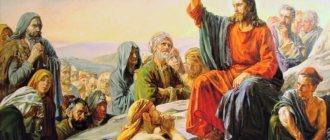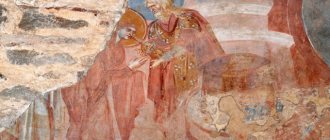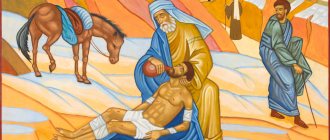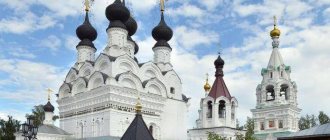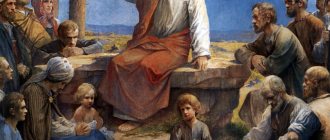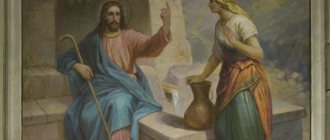According to Tradition, the deceased Jesus Christ, after the crucifixion, brought the soul out of hell; this is not in the New Testament
In the canonical Gospels there is no story about how Christ brought the souls of the dead out of hell. So it is not surprising that people who, even if they picked up the Bible, did not find this episode in the texts of Mark, Matthew, Luke and John.
There is not a single detailed description of such an action of Jesus Christ in the Bible. But there are a number of indirect signs on which the dogma with these ideas is built.
The Apostle Peter writes:
“For Christ also, in order to bring us to God, suffered once for our sins, the righteous for the unjust, being put to death in the flesh, but made alive in the Spirit, by whom He went and preached to the spirits in prison” (1 Pet. 3:18- 19).
Peter
apostle
Orthodox Life
Reflections on Holy Saturday by Archimandrite Sylvester (Stoichev), professor of KDAiS.
Holy Saturday. Easter is very close. We are almost touching the Feast of Holidays. The service of Holy Saturday is already in the light of Easter: white vestments, quiet pre-Easter joy in the melodies. Jesus Christ is God and man. And like a man, He has a soul. And if the body of Christ was dead these three days, then what happened to His soul?
There are no direct indications of this in the Four Gospels.
And in the Apostolic Epistles there are not many texts that answer this question.
But they are quite enough.
“Christ, in order to bring us to God, once suffered for our sins, the righteous for the unjust, being put to death in the flesh, but made alive in the Spirit, by which He went and preached to the spirits in prison” (1 Pet. 3:18). “...The gospel was preached to the dead” (1 Pet. 4:6). “He also descended first into the depths of the earth” (Eph. 4:9).
So, Christ went to a certain place, which is called in the indicated texts “dungeon”, “hell”, and there he preached to the dead.
What is this place we are talking about? It is traditionally called hell. Christ has descended into hell!
Now the word “hell” is perceived by us as the opposite of heaven. Sinners are in hell, righteous people are in heaven.
But the biblical hell, or Sheol in Hebrew, is something completely different. After the fall of Adam and Eve, heaven was inaccessible to people. And not because of their personal sins, but because of the insurmountable gap that arose between God and man. Everyone descends into the Old Testament Sheol - both the righteous and the sinners. All people on earth. Sheol is a place where there is no joy, it is a place of sorrow. And although in pre-New Testament times the Jews had ideas about a certain gradation in hell-Sheol, where the righteous were in one place and the sinners in another, this did not radically change the main content of the doctrine of Sheol.
The doctrine of Sheol, in essence, is the doctrine of the triumph of death. Death, as the main consequence of the Fall, rules everyone. She collects her dues. And no one can avoid this. Figuratively speaking, death has the right to every person, because everyone has sin. And if there is sin, then death also has power: “...Sin entered into the world, and death through sin...” (Rom. 5:12).
The Apostle Paul calls this total dominion of death over the human race the reign of death (Rom. 5:14). In one of the sermons of St. Basil there are words that clearly characterize the power of death: “Death shepherded people... until the true Shepherd came...” Until Christ the Good Shepherd, death shepherds humanity... and Had-Sheol is its rightful kingdom.
The devil, as the enemy of the human race, seeks to drive everyone into the corral of death. He needs it, he enjoys it, because death is the opposite of the life that the Lord created.
God is not only the God of the living, but also the God of the dead, which is why He, appearing to Moses, calls Himself “the God of Abraham, and the God of Isaac, and the God of Jacob,” who at that time were already dead. For the Almighty, everyone is alive: both those who are still in the flesh and those who are no longer...
The God-man Jesus Christ came to save the human race. And not only their contemporaries, but also those who will come after, and those who came before...
But those who died before the Incarnation and Redemption were in hell-sheol. And Christ descends into hell to save them.
Holy Saturday is the day on which the Church remembers the descent of Christ into Sheol.
In the works of many holy fathers there is an idea according to which the devil sought to kill Christ. Knowing the seemingly indestructible power and power of death, the devil wants the death of Jesus. He thinks that by killing Christ he will defeat him. That is why, as St. writes. Photius, the devil “longed for the Cross,” rejoicing in the torment and blood of the Savior.
Christ died. An unimaginable paradox. The One Who is called the Giver of Life has died... The Giver and Source of life has died.
How can this be? How can this be explained?
Jesus Christ is God in the flesh. The Second Hypostasis of the Most Holy Trinity, God the Son, for the sake of saving people, became incarnate and became man. Human nature acquired its real existence in the Person of God the Word, and therefore “Christ is all perfect God, but not all in Him is God; for He is not only God, but also man.” There are two natures in Christ: Divine and human. But there is only one Hypostasis (Personality) – the Hypostasis of God the Son.
Therefore, if we ask “Who?”, for example, performs this or that action, we will receive the answer: God the Word. But if we ask the question “What?”, the answer has to do with nature. The Apostle Paul has the expression “They crucified the Lord of glory.” Who was crucified? Gentlemen. What suffered on the cross? Human nature.
Who went down to Sheol? Lord. What went down to Sheol? Soul.
The church hymn says: “In the tomb with flesh, and in hell with soul as God, in paradise with the thief and on the throne, you, Christ, were with the Father and the Spirit, filling everything, limitless.”
So, God the Son, in His death according to humanity, remains with His body, but with His soul descends into hell and remains inseparably with the Father and the Holy Spirit. St. John of Damascus writes: “Although Christ died as a man, and His holy soul was separated from his most pure body, yet His Divinity remained inseparable from both.”
Therefore, not just another human soul descends to hell, as the devil expected, but the soul of the God-man.
In hell, as the Apostolic Epistles say, Christ preached to the souls of the dead.
St. Epiphanius of Cyprus very colorfully describes how the souls in Sheol await deliverance, because both the prophets and the righteous descended into Sheol, who heralded the coming of the Messiah. And so, when the soul of Christ descends into hell, when light fills the darkness of hell, souls strive from all corners of Sheol to their Savior, who did not leave them, but came for them!
The Church sings in hymns: “When You descended to death, Immortal Life, then You killed hell with the radiance of the Divine.” Hell cannot withstand the power and glory of God and is torn from within, crushed at its foundations.
The icon of Christ's descent into hell depicts the broken gates of hell and Jesus holding the hands of Adam and Eve.
Old Adam and New Adam. The New Adam came to take the Old Adam from the place of sorrow. Adam and Eve are the first parents and the first sinners. The most ancient inhabitants of Sheol. How many generations of their descendants did they meet in hell, and they all became prisoners of hell. But the Deliverer came. The devil, death and hell are put to shame. The joyful rulers of human souls were left with nothing! “Hell remains empty,” says the chant. "Death! where is your sting? hell! where is your victory? (1 Cor. 15:55), exclaims the Apostle Paul.
Christ spent three days in the tomb... We confess that during this time His soul descended into hell, from where He brought out the souls of men.
We know that Christ is Risen. We have known this for two thousand years, and therefore for us Holy Saturday is not a terrible day...
But let’s imagine the first Holy Saturday... This is the day after the funeral of Christ. The next day after the Crucifixion and Death. Anyone who has buried loved ones knows what the next day after the funeral is...
Probably no one can convey the feelings of Christ’s disciples on that Saturday...
Could God leave his disciples in such grief? Three days. This is exactly how long Christ had to stay in the tomb. The Lord Himself speaks about this: “As Jonah was in the belly of the whale for three days and three nights, so the Son of Man will be in the heart of the earth for three days and three nights” (Matthew 12:40). However, out of love for His disciples, in order to shorten the time of their sorrow and quickly give them joy, Christ does not reduce the number of days of His stay in the tomb, but reduces the number of hours. He remained buried for three days, but not 72 hours. Saint Leo the Great explains it this way: “In His mercy, so that long sorrow would not torment the troubled souls of the disciples, He shortened the announced three-day period with such amazing speed that by adding to the whole second day the last part of the first and the first part of the third, He shortened the period for a while, and the number of days did not decrease.”
There is nothing stronger than death... and love. They are not comparable. They are opposite. And if you compare them, then only in terms of strength. The Old Testament Book of Song of Songs says so: “For love is strong as death” (Song. 8:6). But God showed us and revealed in His Son that love is stronger than death, because for the sake of love one can enter the boundaries of death, but death cannot cross its boundaries, cannot go beyond its limits. A lover has the strength to die for the sake of his loved ones, but death cannot love, because love is unity, and death is separation.
God Himself is love (1 John 4:16). And for the sake of love, He ascended the Cross and crossed the boundaries of the kingdom of death. Death is put to shame. Death has been defeated. Its fortress is destroyed, and death is weakened. She is defeated by her own weapons, for Christ “trampled down death by death.”
The ancient words of Scripture read: “And God finished on the seventh day His work that He had done, and rested on the seventh day from all His work that He had done” (Gen. 2:2). The seventh day is Saturday (Ex. 16:26). All Old Testament injunctions and commands are prototypes of New Testament times.
Sabbath of the Old Testament, a day of honor, a day dedicated to the Lord. In the New Testament, the Old Testament veneration of the Sabbath is interpreted as a prototype when God the Word rested in His flesh after what was accomplished on the Cross. Today it is sung: “The great Moses mysteriously foreshadowed this day, saying: “And God blessed the seventh day,” for it is a blessed Sabbath. She is the day of repose on which the Only Begotten Son of God rested from all His works. Through providential death in the flesh, having rested in the flesh and returning again to what He was through the resurrection, He gave us eternal life, as the only good and Lover of mankind.” Holy Saturday. Most Blessed Saturday.
Archimandrite Sylvester (Stoichev)
There are prophecies in the Old Testament that the Savior would go to hell
Most Christians believe that the descent into hell is the act of the Messiah predicted by the prophets. It had to happen for Jesus Christ to confirm the fact that He is the Savior. The author of the Gospel of Matthew writes about these words of Jesus:
“As Jonah was in the belly of the whale three days and three nights, so the Son of Man will be in the heart of the earth three days and three nights.”
Mf. 12:40
Jesus brings the righteous out of hell
The prophecy itself is repeated many times in the Old Testament:
“Have the gates of death been opened for you, and have you seen the gates of the shadow of death?”
Job. 38:17
“I will redeem them from the power of hell, I will deliver them from death. Death! where is your sting? hell! where is your victory?
Os. 13:14
“Lift up your heads, O gates, and be lifted up, O everlasting doors, and the King of glory will come in!”
Ps. 23:7
“...I will break the copper doors and break the iron bars; and I will give you the treasures kept in darkness and the hidden riches.”
Is. 45:2-3
The theme of the descent into hell goes back to the religion of Mesopotamia
Jesus Christ was not the first who, according to legend, fell into hell. Similar myths have been known since ancient times:
- In Kenya they told of Marue in the underworld;
- In New Zealand there was a myth about Para and Hutu;
- The Iroquois tribes spoke of Sayadio in the land of the dead;
- The Chinook passed down a story from generation to generation about a blue jay that visited the afterlife.
But what is most interesting to us is the most ancient myth from Mesopotamia, which, of course, influenced Christian ideas. This story already existed around the 20th century BC, and perhaps even earlier, in oral tradition.
An ancient figurine of the goddess Ishtar, who, like Jesus, had a divine-human nature, died, visited the kingdom of the dead and was resurrected
The goddess Ishtar went to the kingdom of the dead - to where there is no return. Its exact motives are not preserved in either Akkadian or Sumerian sources. At the same time, the goddess knew exactly what she was risking.
She alternately passed through the seven gates of hell, where the guards demanded that the goddess take off an item of clothing or jewelry. And these things are power. As a result, the goddess was left without even a loincloth and died from the gaze of the mistress of the underworld.
But one of the gods created two asexual creatures to save Ishtar. Why asexual?
- Sex implies reproduction. That's life. And life has no place in the kingdom of the dead;
- Only a female or male creature can die. The asexual is invulnerable to death.
The ancients believed that only a chaste creature could emerge from the afterlife.
By the way, this is where the tradition of celibacy and celibacy among priests, priests and monks comes from.
These two creatures brought the seed of life to the goddess and resurrected her.
The most curious thing in this story is that Ishtar was simultaneously the wife of both god and man, which means she herself had a dual nature - half-goddess, half-man.
This theme of the descent into hell of a divine-human figure is recorded for the first time in human culture. The story of Ishtar did not end there, but this information is enough for us.
The apocryphal Gospel of Nicodemus is the main source of information about the descent of Christ into hell
Perhaps the story of the descent of Jesus Christ into hell would not have received such development if not for the apocryphal gospel of Nicodemus. The text was probably created in the 3rd or 4th century, although it is attributed to the Pharisee Nicodemus, a contemporary of Christ.
Here the idea is presented in detail that before the sacrifice of Christ on the cross, the gates of heaven were closed to all people.
The Gospel of Nicodemus is rich in picturesque images: here Satan communicates with hell, and the angel who guards the entrance to heaven, the author has not forgotten Adam and his many descendants. But the manuscripts do not mention Eve.
Jesus Christ talks with the Pharisee Nicodemus. It is Nicodemus who is credited with the text that describes the descent of Christ into hell
One can detect a number of direct borrowings from Mesopotamian religion. The copper gates are clearly the same gates of hell through which Ishtar passed.
The Christian teaching about Christ's descent into hell is based almost entirely on this text. This is surprising, because the gospel itself is not included in the canon.
How did Christ end up in hell?
According to the Bible, due to the fall and apostasy of people from God, for a long time the road to heaven was closed to both sinners and the righteous. All people, regardless of their actions committed during life, after death went exclusively to hell. It is noteworthy that the righteous had a separate place in the underworld called Abraham's womb. Some theologians, such as Ignatius Brianchaninov, consider Abraham’s womb to be a kind of branch of heaven in hell. Monk Simeon the New Theologian writes “once upon a time Christ our God, after he was hanged on the cross and nailed to it the sin of the whole world, descended into the depths of hell, then, rising from hell, again entered His immaculate body and immediately rose from the dead and then, Finally, he ascended into heaven with much power and glory, died, descended into the underworld, and then, rising from there, again “entered His immaculate body and was resurrected.”
Jesus preached a sermon in hell
We will leave the story of death on the cross for another conversation. Moreover, she is widely known. But the details of the descent into hell are worth telling.
St. John of Damascus mentions the preaching of Christ in hell:
“The deified soul descends into hell, so that, just as the Sun of righteousness will shine for those who were in the earth, in the same way the light will shine for those who were underground, who were in darkness and the shadow of death; so that, just as the Lord preached peace to those on earth, liberation to the captives and recovery of sight to the blind, and became the cause of eternal salvation for those who believed, and the reproof of unbelief for those who did not believe, in the same way he preached to those in hell.”
John of Damascus
one of the Church Fathers
Orthodox prayers
The celebration of Jesus' descent into hell is celebrated on Holy Saturday. Holiday services are held in churches. On the eve of Easter Resurrection, hymns are remembered, announcing the descent of Christ into the underworld. The clergy read the stichera of John of Damascus and the prophecy of Jonah, who perished in the belly of the whale and came out again.
Prayer and troparion are intended for the private glorification of the Resurrection of the Savior.
Prayer to Holy Easter
O Most Sacred and Greatest Light of Christ, Who shone forth more than the sun throughout the whole world in Your Resurrection! In this bright and glorious and saving laziness of Holy Pascha, all the angels in heaven rejoice and every creature rejoices and rejoices on earth and every breath glorifies Thee, its Creator. Today the gates of heaven have opened, and I, having died, have been freed into hell by Your descent. Now everything is filled with light, the heavens are the earth and the underworld. May Your light come into our dark souls and hearts and may it enlighten our present night of sin, and may we also shine with the light of truth and purity in the bright days of Your Resurrection, like a new creation about You. And thus, enlightened by You, we will go forth in luminosity at the meeting of You, who comes to You from the tomb, like the Bridegroom. And as Thou didst rejoice on this bright day by Thy appearance of the holy virgins who came from the world to Thy grave in the morning, so now enlighten the deep night of our passions and dawn upon us the morning of passionlessness and purity, so that we may see Thee with our hearts, redder than the sun of our Bridegroom, and may we hear once again Your longed-for voice: Rejoice! And having thus tasted the Divine joys of the Holy Pascha while still here on earth, may we be partakers of Your eternal and great Pascha in heaven in the unevening days of Your Kingdom, where there will be unspeakable joy and those celebrating the unceasing voice and ineffable sweetness of those who behold Your ineffable kindness. For You are the True Light, enlightening and illuminating all things, Christ our God, and glory befits You forever and ever. Amen.
The Holy Fathers argued why Christ descended into hell: to free all souls or only the righteous
Since the idea of the Savior's descent into hell is almost not based on Holy Scripture, disputes arose among the holy fathers about why Jesus descended into hell.
The idea common to Christianity is that previously there was only hell - a dark place where souls do not suffer, but simply await some kind of judgment day. In this case, there is no difference whether the soul is of a righteous person or a sinner. Jesus Christ made it possible for souls to go to heaven and be saved.
So why Jesus went down to hell is clear to us. But for whom is the question.
Christianity teaches that until the sacrifice of Christ, the dead were not allowed into heaven.
Saint Gregory (the Theologian), believed that God’s mercy extended only to the Old Testament righteous:
“Christ, having appeared to those in hell, does not save everyone without exception, but only those who believe.”
Gregory (Theologian)
theologian
But there were also alternative opinions.
Pope Gregory Dvoeslov mentions them in a letter when he addresses a couple of Constantinople clergy:
“After your departure, I learned... that your love said that the Almighty Lord our Savior Jesus Christ, having descended into hell, saved everyone who there confessed Him as God and freed them from deserved punishments. I wish that your brotherhood would think about this completely differently, namely, that He who descended into hell freed by His grace only those who believed that He would come and lived according to His commandments. For it is known that even after the incarnation of the Lord, no one can be saved, even among those who believe in Him, unless they live by faith, as it is written: “Whoever says, “I know Him,” but does not keep His commandments, is a liar. "(1 John 2:4); “faith without works is dead” (James 2:26).
Grigory Dvoeslov
Pope
So, if today believers are not saved without good deeds, and unbelievers and the condemned are saved without good deeds by the Lord who descended into hell, then the fate of those who did not see the incarnate Lord is much better than those who were born after the mystery of the incarnation. How stupid it is to say and think like this, the Lord himself testifies to this when he tells his disciples: “Many prophets and kings wanted to see what you see, but did not see it” (Luke 10:24).
But in order not to occupy your love for a long time with my reasoning, I advise you to read what Philastrius wrote about this heresy in his book on heresies. Here are his words: “There are heretics who say that the Lord, having descended into hell, preached about Himself to everyone there after their death, so that those who confess Him there would be saved, whereas this is contrary to the words of the prophet David: who is in hell? I will confess to You (Ps. 6:6), and to the words of the Apostle: those who, not having the law, have sinned are outside the law and will perish (Rom. 2:12).”
Blessed Augustine also agrees with his words in his book on heresies. So, having considered all this, do not contain anything other than what the true faith of the Catholic Church teaches.”
Exodus and its celebration
The word “Easter” itself (Heb. - “Passover”) comes from the verb “to pass” with the meaning “to deliver”, “to spare”.
Passover is a real historical event that occurred in Egypt in the 13th century BC, when, according to Tradition, the Angel of the Lord passed by Jewish houses sprinkled with the blood of a sacrificial lamb and struck with death all the Egyptian firstborns.
The fact is that for several centuries before this event, the Jewish people were enslaved by the Egyptians. Pharaoh responded to repeated requests from the Israelites to let them go with an invariable refusal. During the last decades of slavery, their situation worsened significantly. The Egyptian authorities, concerned about the “excessive” number of Jews, ordered the death of all boys born to them.
The leader of the Israeli people, the prophet Moses, at the command of God, tried to reason with the stubborn Pharaoh and achieve liberation. The so-called “10 Egyptian plagues” are connected with this, when all of Egypt (except for the place where the Jews lived) alternately suffered from an invasion of toads, midges, poisonous flies, locusts, pestilence, etc.
These were clear signs of God's presence among the Jews, but Pharaoh did not give up and did not release free labor. Then the last, tenth plague occurred in Egypt. God, through Moses, commanded each Jewish family to slaughter a lamb (one-year-old lamb or male goat), bake it, and eat it with unleavened bread and bitter herbs. The meal took place in the evening; it was necessary to eat standing and with great haste, because God promised that the Jews would leave Egypt at night. You should anoint the doorpost of your home with the blood of the lamb. This was a sign for the angel who killed all the firstborn of Egypt, from the firstborn of Pharaoh's family to the firstborn of the cattle, but passed by those houses whose doors were anointed with the blood of the lamb.
Christ in the form of a lamb. Syanovsky quarries. Photo source viaestvita. org
After this execution, the frightened Pharaoh released the Jews from Egypt that same night. Since then, Passover has been celebrated by the Israelis as the day of deliverance from Egyptian slavery and the salvation of all Jewish firstborns from death.
However, the celebration took place not one day, but seven. Every devout Jew had to spend these days in Jerusalem. During the holiday, all leavened products were taken out of the houses, and only unleavened bread (matzo) was eaten, in memory of the fact that the Jews’ exit from Egypt was so hasty that they did not have time to leaven the bread and took with them only unleavened flatbread. Hence the second name of Passover - the Feast of Unleavened Bread.
Each family brought a lamb to the Temple, which was slaughtered there according to a ritual specially described in the Law of Moses. According to the Jewish historian Josephus, on the Passover of 70 A.D., 265,500 lambs were slaughtered in the Temple in Jerusalem. Perhaps this figure is greatly exaggerated, as is often the case with Josephus, but even if we reduce it by several orders of magnitude, the picture of what happened on that day in the Temple is impressive.
The family had to bake this lamb, which was called Passover, and be sure to eat it completely in the evening on the first day of the holiday at the Passover meal called Seder. This dinner was the main event of the celebration. Also, the obligatory diet of the Passover meal included bitter herbs (in memory of the bitterness of slavery), charoset (a paste of fruits and nuts) and four glasses of wine. The father of the family was supposed to tell the story of the exodus of the Jews from Egyptian slavery over the meal, both in gratitude to God and as a reminder of the special connection of his people with Him.
The Passover meal could only be held in Jerusalem, within its city walls. Therefore, the pilgrims negotiated with local residents, who provided them with free rooms or allowed them to have the Easter meal in the courtyard or on the roof of the house. It was not allowed to take money for the premises, but the owners were usually left with the skins of killed animals as compensation. The poor who had no money received special assistance to purchase everything they needed. In addition, it was considered godly to invite poor brothers to one’s holiday.
The celebration of the Old Testament Passover is described here in the past tense, since with the coming of Christ it loses its meaning, however, without any special changes, the Jews still celebrate Easter in this way. The main difference between the current Jewish Passover is that there is no lamb at the meal. It is symbolized by a ram's bone, because according to the law of Moses, a lamb cannot be slaughtered anywhere except the Temple in Jerusalem, which was destroyed by the Romans in 70 A.D.
Most liturgical texts and Church Fathers are convinced that one cannot repent in hell
The version that sinners in hell had a chance to repent was rejected by the majority of Christian leaders. In their opinion, we are talking about salvation while a person has not yet died. Accordingly, after His descent, Jesus brought the souls of only the righteous out of hell, and sinners had no chance for this.
Any statement by the holy fathers about the descent into hell almost always revolves around this idea. For example, this is what St. Barsanuphius the Great writes:
“As for knowledge of the future, do not be mistaken: what you sow here, you will reap there. After leaving here, no one can succeed... Brother, here is work - there is reward, here is feat - there are crowns.
Barsanuphius the Great
monk
The Savior had to spend 3 days and 3 nights in hell, according to the prophets.
Saint John Chrysostom agrees with him:
“Only real life is a time for exploits, and after death there is judgment and punishment. “In hell,” it is said, “who will confess You?”
John Chrysostom
archbishop
Date of Resurrection
Now it is impossible to determine exactly what date (according to our calendar) the event of the Resurrection occurred. Based on the Gospel data, only one thing can be said with confidence: according to the Jewish calendar, Christ was crucified on Friday, the 14th day of the first spring month of Nisan, and resurrected on the “first day of the week,” the 16th day of Nisan.
What is the "first day of the week"? The Jewish week also consists of seven days, but its last day is Saturday (from the Hebrew “sabbath” - “rest”, “abstinence”). That is, Christ rose again the day after Saturday. Even among the first Christians, this day stood out from all the others and was called “the Day of the Lord.” Later in Slavic countries it was called Sunday.
The first spring month of Nissan corresponds to March - April. The Jews lived not according to the solar calendar, but according to the lunar calendar, and Nisan was the first month of the new year. It began on the new moon closest to the spring equinox. And the first day of Passover was always celebrated by the Jews on the 14th day of Nissan and always coincided with the first full moon of spring. The solar and lunar years differ from each other by 11 days (365 and 354). It is clear that for a person living according to the solar calendar, the days of the lunar calendar will fall on different days of the week every year. In addition, errors accumulate very quickly in the lunar calendar in comparison with the astronomical year, and there are no rules for correcting them.
The theme of Christ's victory over death is widely represented in liturgics and iconography
The victory of Christ over death has become one of the favorites of the authors of icons and church hymns. On icons in different scenes, the Savior leads Adam and Eve out of hell, or simply leads a group of righteous people. The theme of the resurrection of Christ is closely connected with this plot.
Initially, the iconography of this episode did not exist independently in the Russian and Byzantine traditions. The image of Christ's resurrection in the tomb arose quite late.
An icon with the theme of death and hell exists not so much for prayers, but so that a person does not forget about the victory of Christ over hell and strives for a righteous life.
Icon of the Descent of Jesus Christ into Hell
And here is an example of the same theme in the Service of the Week of the Cross:
“Pilate planted three crosses on Calvary, two of thieves, and one of the Life-Giver. He saw hell, and said to those who are: O my servants and my strength! Who, having planted a nail in my heart, suddenly pierced me with a wooden spear? And I am torn to pieces by my inner pain, I am wounded in my belly, my feelings confuse my spirit, and I am forced to vomit out Adam, and those that are from Adam, given by the tree; the tree bo this brings you into paradise.”
By leaving a comment, you accept the user agreement
